Brown Kukri Snake
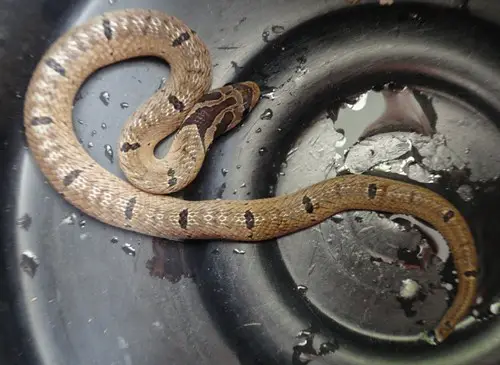
Oligodon purpurascens (Brown Kukri Snake)
Thais say: Ngoo koot
Appearance: Typical kukri shape – not long, but thick snakes with a short tail and no real separation between neck and head. Very small head. Pattern on top of head indicative of most kukri species. Venter is creme or pink.
Length: Average just under 1 meter (about 37 inches)
Range: All over Thailand. Brown Kukri snakes were once thought to be native to only the southernmost Thailand provinces, however J. Bulian has found one in Pattaya and there have been others discovered farther in the northeast. Assume the Brown Kukri’s habitat is across most of Thailand.
Habitat: These snakes prefer life in the forest and can be found at great elevations – about 1 mile high (1,600 meters). I have received numerous requests to identify this snake from readers who found them close to or inside their homes as well. The habitat is wide and varied for this species. Regardless where they are found, they enjoy living under brush, wood, rocks, and thick flora.
Active Time? Nocturnal, active at night and in the early morning as the sun rises. I have also found them in the middle of the day, and toward evening before sunset.
Food: Frogs, lizards, geckos, skinks, and their eggs.
Defensive Behavior: If the brown kukris are bothered enough they will roll their body to the side and lift up their tail – perhaps to present it as a place to attack – leaving the mouth free to strike when the aggressor does go for the tail. Kukri snakes have specialized egg-slicing teeth in the back of the jaw which are enlarged and shaped like a kukri knife. When held by the head, this snake can expertly twist the jaw around to stick the handler with these teeth. Holding is not recommended.
Venom Toxicity: No venom.
Offspring: Lay 6-12 eggs. A reader reported his snake had 8 eggs the first time and 10 the next. Eggs hatched after 60 days, incubated at 29 degrees C. Hatching in Bangkok latitude around late April.
Notes: Though this snake is not venomous, it is keen to bite and can inflict deep wounds due to it’s large, curved teeth and strong bite. Michael Cota, researcher, says, “Appears that it might be an evolutionary link on the way to being venomous, since it is the only snake that I can think of that has “fangs” (enlarged pair of teeth), but no venom delivery system or ducts to the teeth. They are not dangerous, but will give you quite a bloody bite that takes a long time to heal. What makes them so difficult is that their head is not distinct; therefore, it is extremely difficult to grab behind the head and keep proper control of it. It maneuvers it head around on your grip and then uses teeth to bite – slash.”
You’ll need a tetatus shot if you are bitten, as with all snakes as a precaution.
Kukris are common and you might see one in Thailand if you live here.
Brown Kukri Scientific classification
Kingdom: Animalia
Phylum: Chordata
Subphylum: Vertebrata
Class: Reptilia
Order: Squamata
Suborder: Serpentes
Family: Colubridae
Subfamily: Colubrinae
Genus: Oligodon
Species: Oligodon purpurascens
Binomial name: Oligodon purpurascens
Classified by Schlegel in 1837.
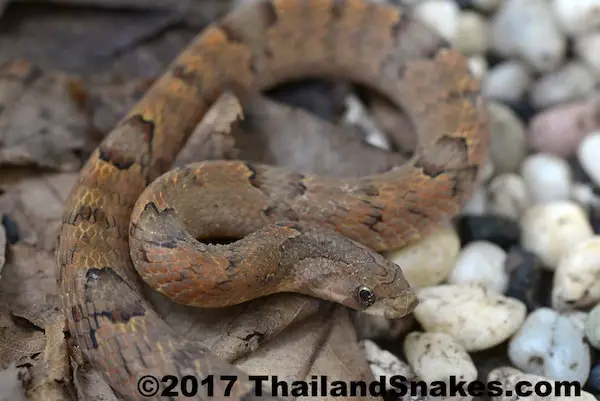
- Common Non-Venomous Snakes Post #1 Post #2
- Brahminy Blind Snake
- Brown Kukri Snake
- Copper-Headed Racer / Radiated Rat Snake | IndoChinese Rat Snake | Oriental Rat Snake / Banded | Red-Tailed Racer | Ridley’s Racer | White-Bellied Rat Snake
- Dragon Snake
- Laotian Wolf Snake
- Malayan Bridle Snake
- Orange-Bellied Snake
- Red-Tailed Pipe Snake
- Reticulated Python | Blood Python | Burmese Python
- Striped Bronzeback
- Sunbeam Snake

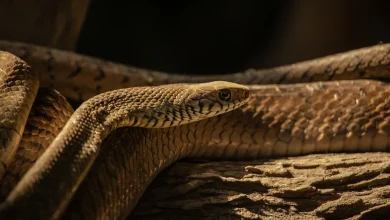
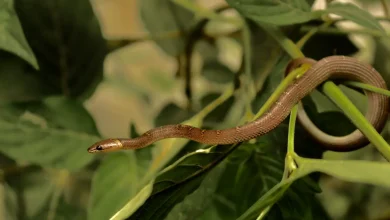
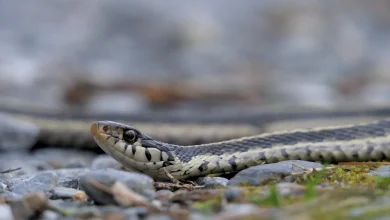
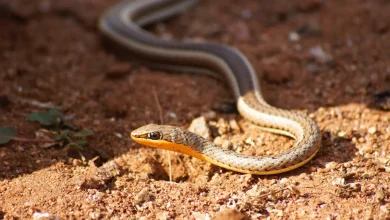
Hi Vern
I have a house in Chonburi about 13 klms from downtown Pattaya.
In my time here I have seen quite a few Copperheads and Tree snakes. About a year ago I’m sure I had a cobra in my garden but it disappeared next door. Are cobras common around Pattaya ?
many Thanks
Tony
Cobras are very common everywhere – the monocled cobras, Naja kaouthia, are all over the country, and in good numbers. King cobras and the spitting cobras are much more rare.
I just saw one of these in my backyard in Chiangmai. It was too quick to escape before I could get a photo of it. The back of the body had light and dark brown stripes along the body.
Hi, I think the one on the pic is Oligodon fasciolatus instead of Oligodon purpurascens. nice post though
I found one tonight(or rather my dogs did) in Chiang Mai… so that’s a golden tree snake, a few loation wolf snakes, a couple of rat snakes and a black rainbow snake here in the past 3 years, really not many…
I think the photo at the top is a banded Kukri, the brown Kukri is a much more redish brown , if you check it out i think you will find this is correct
Hi Vern, we got a baby brown kukri. Looks like it just hatched from somewhere. Do you know what kind of place to look for its siblings and mom? We should find them before our dog kills them.
I wrote you email. Snakes like to lay eggs at the base of trees. Under leaf litter if possible. Out of the sunshine – would get too hot. In a shady place where nothing is likely to trod and break the eggs. Cheers!